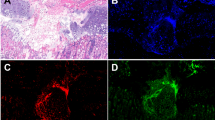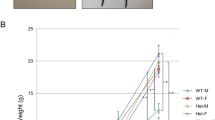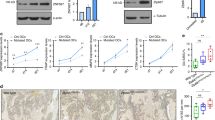Abstract
Background
CREBBP has been extensively studied in syndromic diseases associated with skeletal dysplasia. However, there is limited research on the molecular mechanisms through which CREBBP may impact bone development. We identified a novel pathogenic CREBBP variant (c.C3862T/p.R1288W, which is orthologous to mouse c.3789 C > T/p.R1289W) in a patient with non-syndromic polydactyly.
Methods
We created a homozygous Crebbp p.R1289W mouse model and compared their skeletal phenotypes to wild-type (WT) animals. Bone marrow stem cells (BMSCs) were isolated and assessed for their proliferative capacity, proportion of apoptotic cells in culture, and differentiation to chondrocytes and osteocytes.
Results
We observed a significant decrease in body length in 8-week-old homozygous Crebbp p.R1289W mice. The relative length of cartilage of the digits of Crebbp p.R1289W mice was significantly increased compared to WT mice. BMSCs derived from Crebbp p.R1289W mice had significantly decreased cell proliferation and an elevated rate of apoptosis. Consistently, cell proliferative capacity was decreased and the proportion of apoptotic cells was increased in the distal femoral growth plate of Crebbp p.R1289W compared to WT mice. Chemical induction of BMSCs indicated that Crebbp p.R1289W may promote chondrocyte differentiation.
Conclusion
The Crebbp p.R1289W variant plays a pathogenic role in skeletal development in mice.
Impact
-
CREBBP has been extensively studied in syndromic diseases characterized by skeletal dysplasia.
-
There is limited research regarding the molecular mechanism through which CREBBP may affect bone development.
-
To our knowledge, we generated the first animal model of a novel Crebbp variant, which is predicted to be pathogenic for skeletal diseases.
-
Certain pathogenic variants, such as Crebbp p.R1289W, can independently lead to variant-specific non-syndromic skeletal dysplasia.
This is a preview of subscription content, access via your institution
Access options
Subscribe to this journal
Receive 14 print issues and online access
$259.00 per year
only $18.50 per issue
Buy this article
- Purchase on SpringerLink
- Instant access to full article PDF
Prices may be subject to local taxes which are calculated during checkout





Similar content being viewed by others
Data availability
Data that support the findings of this study are available from the corresponding author upon reasonable request.
References
Calder, A. D. & Foley, P. Skeletal dysplasias: an overview. Paediatr. Child Health (Oxf.) 28, 84–92 (2018).
Bonafe, L. et al. Nosology and classification of genetic skeletal disorders: 2015 revision. Am. J. Med Genet Part A 167, 2869–2892 (2015).
Raisner, R. et al. Enhancer Activity Requires CBP/P300 Bromodomain-Dependent Histone H3K27 Acetylation. Cell Rep. 24, 1722–1729 (2018).
Zimmer, S. N. et al. Crebbp haploinsufficiency in mice alters the bone marrow microenvironment, leading to loss of stem cells and excessive myelopoiesis. Blood 118, 69–79 (2011).
Gao, C. et al. Downregulating CREBBP inhibits proliferation and cell cycle progression and induces daunorubicin resistance in leukemia cells. Mol. Med. Rep. 22, 2905–2915 (2020).
Korzus, E. Rubinstein-Taybi Syndrome and epigenetic alterations. Adv. Exp. Med. Biol. 978, 39–62 (2017).
Tanaka, Y. et al. Abnormal skeletal patterning in embryos lacking a single CBP allele: a partial similarity with Rubinstein-Taybi syndrome. Proc. Natl Acad. Sci. 94, 10215 (1997).
Biesecker, L. G. et al. Elements of morphology: standard terminology for the hands and feet. Am. J. Med. Genet. Part A 149A, 93–127 (2009).
Hall, B. D. et al. Elements of morphology: standard terminology for the periorbital region. Am. J. Med. Genet. Part A 149A, 29–39 (2009).
Zu, B. et al. Identification of the genetic basis of sporadic polydactyly in China by targeted sequencing. Computational Struct. Biotechnol. J. 19, 3482–3490 (2021).
Wang, J. et al. Exome sequencing reveals a novel PTHLH mutation in a Chinese pedigree with brachydactyly type E and short stature. Clin. Chim. Acta 446, 9–14 (2015).
Wang, J. et al. Primary ovarian insufficiency collaboration. mutations in HFM1 in recessive primary ovarian insufficiency. N. Engl. J. Med. 370, 972–974 (2014).
Xiang, Y. et al. A novel nonsense GLI3 variant is associated with polydactyly and syndactyly in a family by blocking the sonic hedgehog signaling pathway. Front Genet 11, 542004 (2020).
Menke, L. A. et al. CREBBP mutations in individuals without Rubinstein-Taybi syndrome phenotype. Am. J. Med Genet A 170, 2681–2693 (2016).
Menke, L. A. et al. Further delineation of an entity caused by CREBBP and EP300 mutations but not resembling Rubinstein-Taybi syndrome. Am. J. Med Genet A 176, 862–876 (2018).
Banka, S. et al. Genotype-phenotype specificity in Menke-Hennekam syndrome caused by missense variants in exon 30 or 31 of CREBBP. Am. J. Med Genet A. 179, 1058–1062 (2019).
Nishi, E. et al. The novel and recurrent variants in exon 31 of CREBBP in Japanese patients with Menke-Hennekam syndrome. Am. J. Med Genet A. 188, 446–453 (2022).
Attar, N. & Kurdistani, S. K. Exploitation of EP300 and CREBBP lysine acetyltransferases by cancer. Cold Spring Harb. Perspect. Med. 7, a026534 (2017).
Xiao, X. et al. Targeting CREB for cancer therapy: friend or foe. Curr. Cancer Drug Targets 10, 384–391 (2010).
Carlezon, W. A. et al. The many faces of CREB. Trends Neurosci. 28, 436–445 (2005).
Tang W., et al. Association study of CREB1 and CBP genes with Alzheimer’s disease in Han Chinese. Asia Pac Psychiatry. 9. (2017)
Hadjipanayis A., et al. Thu0033 Rna profling of healthy and rheumatoid arthritis subjects treated with tofacitinib monotherapy. 284.1–284. (2019)
Akinsiku, O. E. et al. Update and potential opportunities in CBP [cyclic adenosine monophosphate (cAMP) response element-binding protein (CREB)-binding protein] research using computational techniques. Protein J 40, 19–27 (2021).
Sentchordi-Montané, L. et al. High prevalence of variants in skeletal dysplasia associated genes in individuals with short stature and minor skeletal anomalies. Eur. Endocrinol. 185, 691–705 (2021).
Tang, H. et al. Integrative analysis of long non-coding RNA and mRNA in broilers with valgus-varus deformity. PLoS One 15, e0239450 (2020).
Deemer, B. et al. Duplication 16p13.3 and the CREBBP gene: confirmation of the phenotype. Eur. J. Med Genet 56, 26 (2013).
Petrij, F. et al. RubinsteineTaybi syndrome caused by mutations in the transcriptional co-activator CBP. Nature 376, 348e51 (1995).
Hennekam, R. C. et al. Deletion at chromosome 16p13.3 as a cause of RubinsteineTaybi syndrome: clinical aspects. Am. J. Hum. Genet 52, 255e62 (1993).
Ebbesen, K. K. et al. Insights into circular RNA biology. RNA Biol. 14, 1035–1045 (2017).
Ambros, V. The functions of animal microRNAs. Nature 431, 350–355 (2004).
Qiao, J. et al. Microarray analysis of circRNAs expression profile in gliomas reveals that circ_0037655 could promote glioma progression by regulating miR-214/PI3K signaling. Life Sci. 245, 117363 (2020).
Zhang, L. et al. Circ-CREBBP promotes cell tumorigenesis and glutamine catabolism in glioma by regulating miR-375/glutaminase axis. Brain Res 1775, 147730 (2022).
Hutchinson, D. T. et al. Rubinstein–Taybi Syndrome. J. Hand Surg. Am. 40, 1711–1712 (2015).
Yu, P. T. et al. Rubinstein-Taybi syndrome in Chinese population with four novel mutations. Am. J. Med Genet A. 185, 267–273 (2021).
Yu, S. et al. Clinical exome sequencing identifies novel CREBBP variants in 18 Chinese Rubinstein-Taybi Syndrome kids with high frequency of polydactyly. Mol. Genet Genom. Med. 7, e1009 (2019).
Murata, T. et al. Defect of histone acetyltransferase activity of the nuclear transcriptional coactivator CBP in RubinsteinTaybi syndrome. Hum. Mol. Genet 10, 1071–1076 (2001).
Huh, R. et al. Letter to the Editor: a novel mutation in the CREBBP gene of a Korean girl with Rubinstein–Taybi syndrome. Ann. Clin. Lab Sci. 45, 458–461 (2015).
Huang, Q. et al. Caspase 3-mediated stimulation of tumor cell repopulation during cancer radiotherapy. Nat. Med 17, 860–866 (2011).
Kozhemyakina, E. et al. A pathway to bone: signaling molecules and transcription factors involved in chondrocyte development and maturation. Development 142, 817–831 (2015).
Zhang, L. L. et al. Acetyltransferases CBP/p300 control transcriptional switch of β-catenin and stat1 promoting osteoblast differentiation. J. Bone Min. Res 38, 1885–1899 (2023).
Acknowledgements
We express our gratitude to the patients and their families who willingly participated in this study.
Funding
The research was financially supported by grants from the National Natural Science Foundation of China (No. 82372328), the Medicine Guide Project (Chinese and Western medicine) of the Shanghai Science and Technology Committee (No. 18411961400), and the Science and Technology Commission Fund of Shanghai (No. 20ZR1434800). The authors declare no conflicts of interest.
Author information
Authors and Affiliations
Contributions
Conceptualization: Q.F., J.F. and Y.L.X. Formal analysis: B.W., Q.H.F., Y.X. Investigation: F.Q. and X.Q.Z. Writing-original draft preparation: Y.X. Writing-review and editing: Y.X., B.W., Y.L.X. and Q.H.F.
Corresponding authors
Ethics declarations
Competing interests
The authors declare no competing interests.
Ethical approval and informed consent
The study protocol was approved by the Ethics Committee of Shanghai Children’s Medical Center, School of Medicine, Shanghai Jiao Tong University(no. SCMCIRB-K2017008),and written informed consent was obtained from all participants or their legal guardians. All animal procedures were approved by the animal ethics committee of Shanghai Children’s Medical Center (no. SCMC-LAWEC-2019-015).
Additional information
Publisher’s note Springer Nature remains neutral with regard to jurisdictional claims in published maps and institutional affiliations.
Rights and permissions
Springer Nature or its licensor (e.g. a society or other partner) holds exclusive rights to this article under a publishing agreement with the author(s) or other rightsholder(s); author self-archiving of the accepted manuscript version of this article is solely governed by the terms of such publishing agreement and applicable law.
About this article
Cite this article
Fang, Q., Xu, Y., Feng, J. et al. Functional analysis of a novel pathogenic variant in CREBBP associated with bone development. Pediatr Res 96, 1626–1635 (2024). https://doi.org/10.1038/s41390-024-03490-z
Received:
Revised:
Accepted:
Published:
Issue date:
DOI: https://doi.org/10.1038/s41390-024-03490-z



